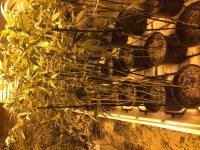So far it has been pain in my rectum.
All the pinching, supercroping (same thing) netting and LST.
I am still trying to form a failproof approach that work every time.
For this, I need to know all the rules that plants use to get bigger, but even then I am not there yet.
Could you please respond on how would you approach on controlling the height of 100+ plants, some of whom may be difficult to reach.
I am thinking of just spray a trellis net across the canopy and just keep tucking them in. Plus my tomato rings will help with LST as well.
Main problem is the quantity. I know I could control 10 or even 20, but a 100. Woohoo...
Thanks
All the pinching, supercroping (same thing) netting and LST.
I am still trying to form a failproof approach that work every time.
For this, I need to know all the rules that plants use to get bigger, but even then I am not there yet.
Could you please respond on how would you approach on controlling the height of 100+ plants, some of whom may be difficult to reach.
I am thinking of just spray a trellis net across the canopy and just keep tucking them in. Plus my tomato rings will help with LST as well.
Main problem is the quantity. I know I could control 10 or even 20, but a 100. Woohoo...
Thanks

 .....
.....


